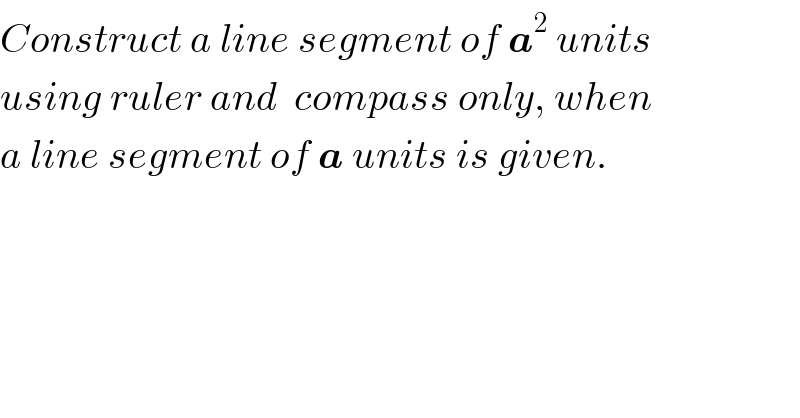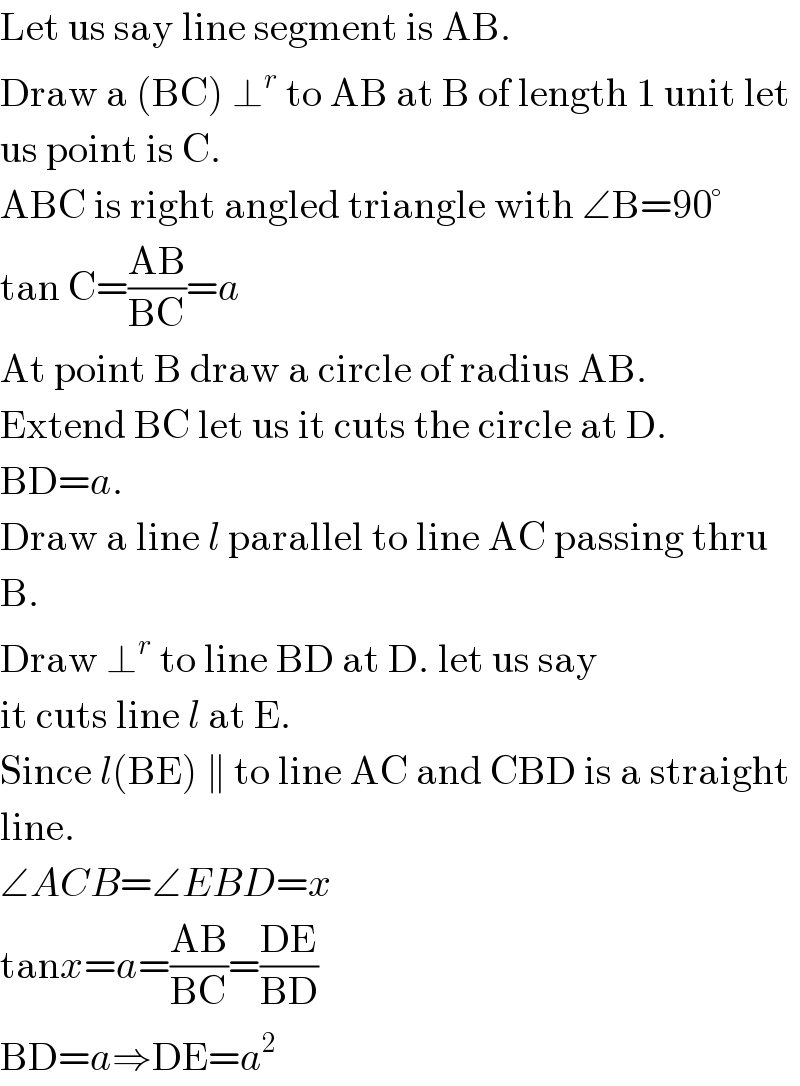Question Number 3607 by Rasheed Soomro last updated on 16/Dec/15

$${Construct}\:{a}\:{line}\:{segment}\:{of}\:\boldsymbol{{a}}^{\mathrm{2}} \:{units}\: \\ $$$${using}\:{ruler}\:{and}\:\:{compass}\:{only},\:{when} \\ $$$${a}\:{line}\:{segment}\:{of}\:\boldsymbol{{a}}\:{units}\:{is}\:{given}. \\ $$
Answered by prakash jain last updated on 16/Dec/15

$$\mathrm{Let}\:\mathrm{us}\:\mathrm{say}\:\mathrm{line}\:\mathrm{segment}\:\mathrm{is}\:\mathrm{AB}. \\ $$$$\mathrm{Draw}\:\mathrm{a}\:\left(\mathrm{BC}\right)\:\bot^{{r}} \:\mathrm{to}\:\mathrm{AB}\:\mathrm{at}\:\mathrm{B}\:\mathrm{of}\:\mathrm{length}\:\mathrm{1}\:\mathrm{unit}\:\mathrm{let} \\ $$$$\mathrm{us}\:\mathrm{point}\:\mathrm{is}\:\mathrm{C}. \\ $$$$\mathrm{ABC}\:\mathrm{is}\:\mathrm{right}\:\mathrm{angled}\:\mathrm{triangle}\:\mathrm{with}\:\angle\mathrm{B}=\mathrm{90}° \\ $$$$\mathrm{tan}\:\mathrm{C}=\frac{\mathrm{AB}}{\mathrm{BC}}={a} \\ $$$$\mathrm{At}\:\mathrm{point}\:\mathrm{B}\:\mathrm{draw}\:\mathrm{a}\:\mathrm{circle}\:\mathrm{of}\:\mathrm{radius}\:\mathrm{AB}. \\ $$$$\mathrm{Extend}\:\mathrm{BC}\:\mathrm{let}\:\mathrm{us}\:\mathrm{it}\:\mathrm{cuts}\:\mathrm{the}\:\mathrm{circle}\:\mathrm{at}\:\mathrm{D}. \\ $$$$\mathrm{BD}={a}. \\ $$$$\mathrm{Draw}\:\mathrm{a}\:\mathrm{line}\:{l}\:\mathrm{parallel}\:\mathrm{to}\:\mathrm{line}\:\mathrm{AC}\:\mathrm{passing}\:\mathrm{thru} \\ $$$$\mathrm{B}.\: \\ $$$$\mathrm{Draw}\:\bot^{{r}} \:\mathrm{to}\:\mathrm{line}\:\mathrm{BD}\:\mathrm{at}\:\mathrm{D}.\:\mathrm{let}\:\mathrm{us}\:\mathrm{say} \\ $$$$\mathrm{it}\:\mathrm{cuts}\:\mathrm{line}\:{l}\:\mathrm{at}\:\mathrm{E}. \\ $$$$\mathrm{Since}\:{l}\left(\mathrm{BE}\right)\:\parallel\:\mathrm{to}\:\mathrm{line}\:\mathrm{AC}\:\mathrm{and}\:\mathrm{CBD}\:\mathrm{is}\:\mathrm{a}\:\mathrm{straight} \\ $$$$\mathrm{line}. \\ $$$$\angle{ACB}=\angle{EBD}={x} \\ $$$$\mathrm{tan}{x}={a}=\frac{\mathrm{AB}}{\mathrm{BC}}=\frac{\mathrm{DE}}{\mathrm{BD}} \\ $$$$\mathrm{BD}={a}\Rightarrow\mathrm{DE}={a}^{\mathrm{2}} \\ $$
Commented by Rasheed Soomro last updated on 16/Dec/15

$$\boldsymbol{{e}\mathcal{XCEL}{lent}}\:\boldsymbol{\mathcal{S}{ir}}! \\ $$
